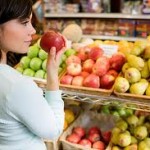 I think I can assume to say that we all like to supply our family with the best of what is offered when it comes to food. We seek out the foods that will give us the nutrition we need while being tasty and appetizing to our palates.
I think I can assume to say that we all like to supply our family with the best of what is offered when it comes to food. We seek out the foods that will give us the nutrition we need while being tasty and appetizing to our palates.
This careful selective process is particularly applied to fruits and vegetables. As we find ourselves having to choose from an array of options we comb the aisles of the produce area hoping to get the best for what is offered. We touch, pinch, hold, smell and observe the color and texture to select the best of the bunch. Somewhere along the line, we find ourselves having to make a decision and this can often come down to affordability.
What we can afford is often what we choose as our economic sensibility takes over whatever criteria we had to make our selection of fruits and vegetables. This can often be a matter of choosing between what is organic and non-organic as prices for these categories alone can sometimes have us feeling trapped to make choices we would not otherwise.
I find it helpful to prepare myself before I go food shopping for the week and look at the list of fruits and vegetables and decide what I will buy organic and non-organic. A resource that I continue to use as it is usually updated each year is The Environmental Working Group (EWG) Shopper’s Guide to Pesticides in Produce which you can find here.
This is a simple, easy to use guide is divided into two categories; “The Clean 15” and “The Dirty Dozen”. This year “The Dirty Dozen” was expanded and renamed “Dirty Dozen Plus” to include leafy greens such as green beans and kale. These greens along with other vegetables and fruits such as apples, peaches, celery, cucumber and spinach are recommend be bought organic.
The “Clean 15” are the produce with the lowest amount of pesticides. These include vegetables such as onions, cabbage and sweet peas and fruits like pineapple, avocado and mango.
When trying to save money while selecting produce that will be best for your family, consider your options. Consulting resources for pesticide usage is one way to divide your list into what can give you peace of mind not just for your family’s food safety but also for your wallet.
(Note that the the list was compiled through research done on 10 years of data from the USDA and the US Dept of Agriculture).
Share your resources for good shopping sense and “cents” with us.


